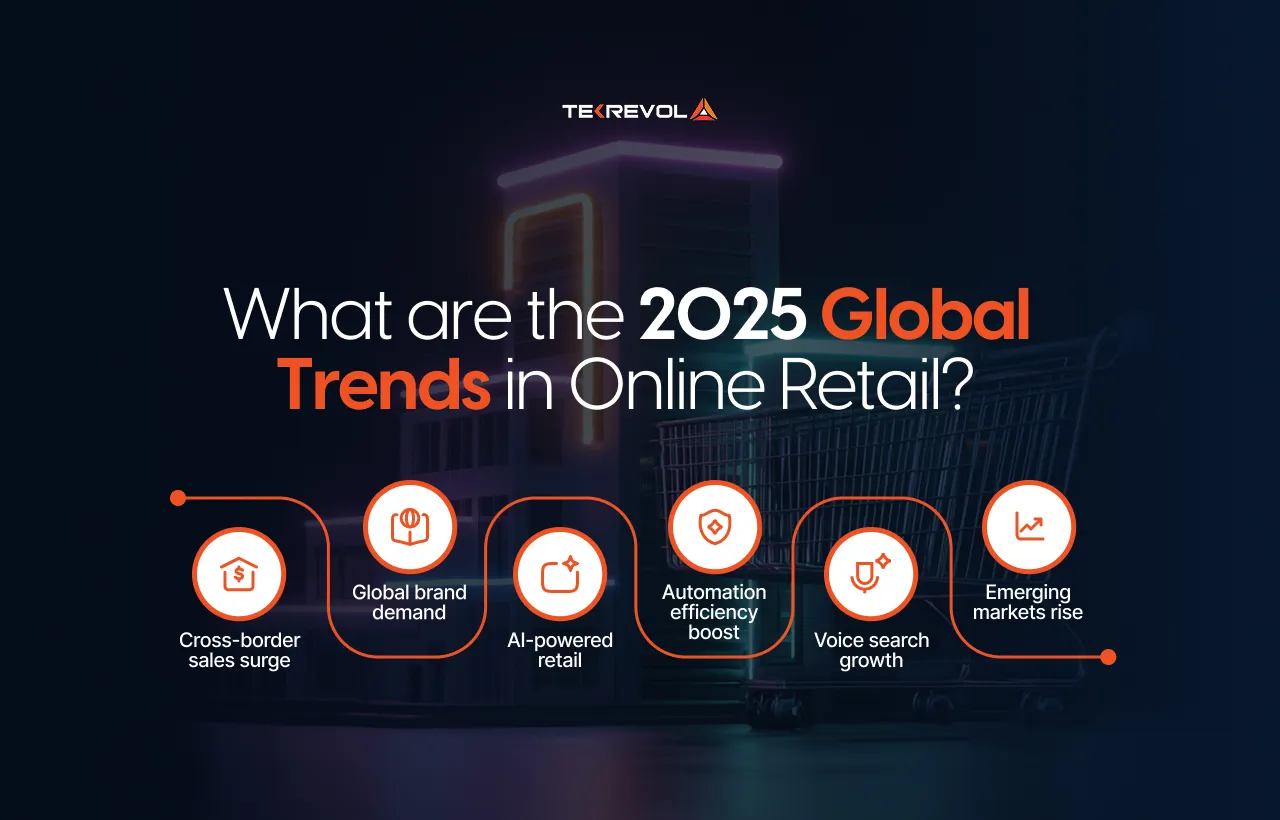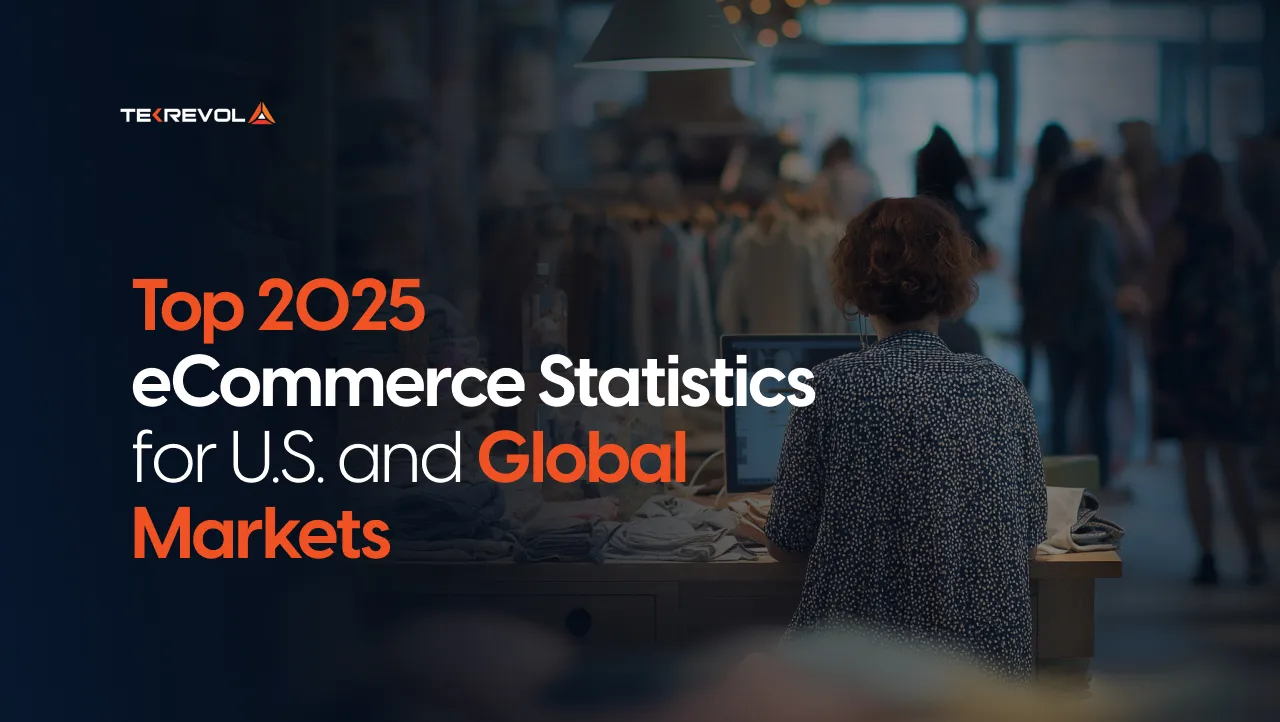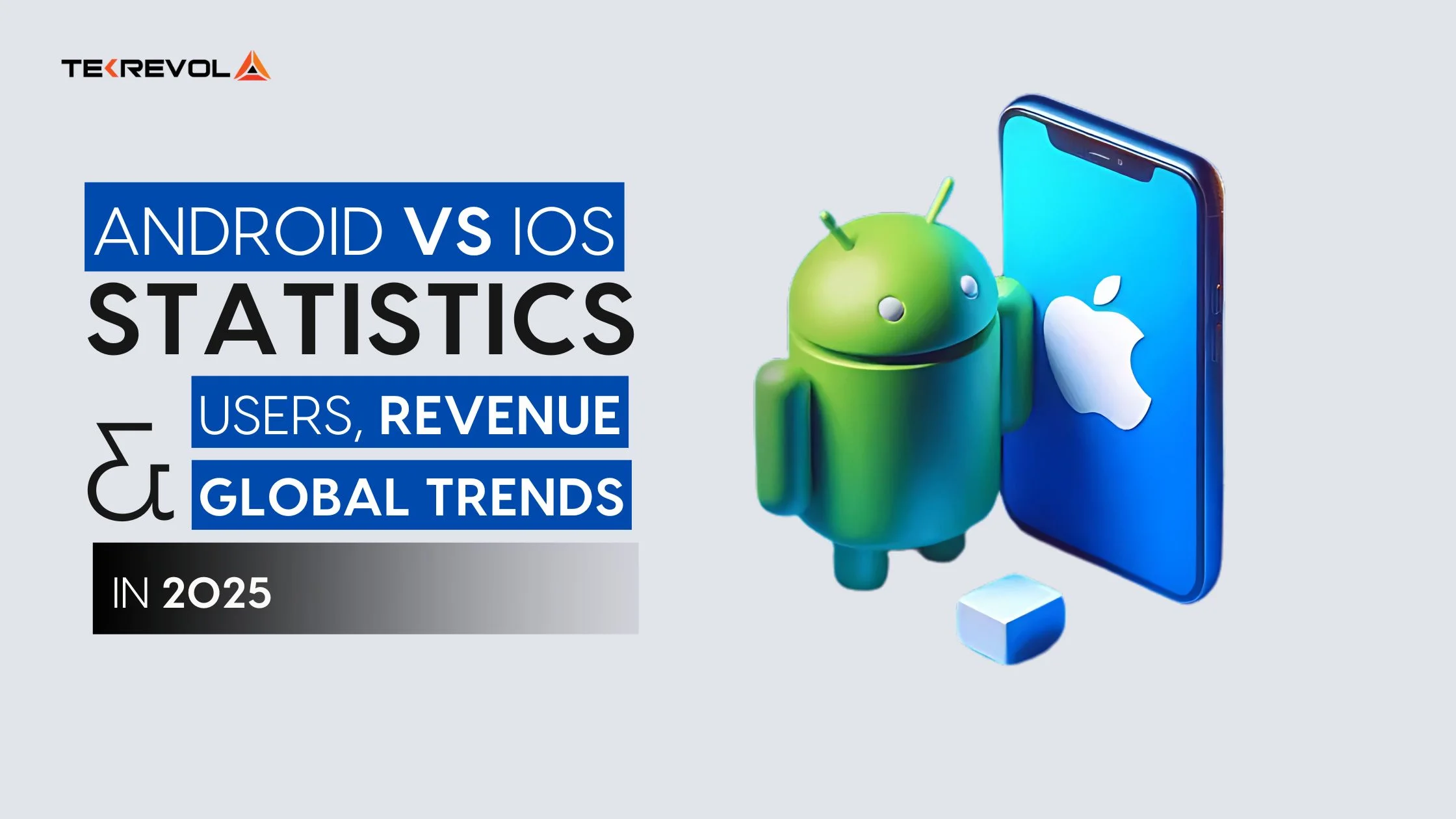Have you ever thought why eCommerce statistics are more important than ever?
The eCommerce landscape in 2025 has reached a defining moment. With millions of digital storefronts and billions of consumers shopping online, global retail is no longer about “online vs. offline”; it’s about integration, personalization, and data. Understanding eCommerce statistics today is not just about tracking numbers; it’s about predicting the future of consumer behavior and business innovation.
With the latest eCommerce statistics on shopping from the internet, more than 2.7 billion online consumers are buying online, with that number still increasing as technology improves and digital confidence increases. The statistics aren’t simply impressive, but they are revolutionary. As a startup, enterprise, or entrepreneur, understanding eCommerce business statistics can assist with formulating strategies, defining the right target audience, as well as scaling wiser.
In this comprehensive analysis, we’ll reveal the top eCommerce statistics defining 2025 in the United States and internationally, from sales to marketplace share to mobile commerce to trends among consumers and brand new developments — so you can base your strategic decisions on facts with a constantly evolving digital marketplace.
What Do Current Global eCommerce Numbers Show for 2025?
The world of eCommerce is at a new level of digital maturity. Convenience used to be what propelled online retail a few years back; now it’s innovation, experience, and personalization that drive it.
Here we go through the most up-to-date world eCommerce statistics that suggest the future directions of online retail in 2025.
Unprecedented Market Growth
The world eCommerce market is still on a record-breaking trajectory. According to 2025 global eCommerce statistics, retail eCommerce sales globally are estimated to exceed $4.3 trillion compared to $5.8 trillion in 2023. This accounts for almost 24% of overall retail sales globally, as online commerce is now cemented as a foundation of retail globally.
Asia-Pacific is still leading the pack with China, India, and Southeast Asian countries accounting for more than 50% of total eCommerce growth. The U.S. and Europe are next, accounting for reliable year-after-year growth with sophisticated logistics, upstanding digital structures, as well as growing comfort with online transactions among consumers.
Mobile Commerce Leadership
Mobile remains supreme in digital retail. The majority, 73% of online eCommerce transactions, now occur on smartphones or iPad devices. The pattern highlights why mobile-optimized checkout flows are so essential for brands. Quick site load times, streamlined checkout flows, and personalized product recommendations are no longer amenities – they are requirements.
This is also connected with online commerce growth statistics that see mobile-first design increase conversion rates up to nearly 45% from levels of desktop-centric pages alone.
The Power of Personalization
Personalization was a performance driver in 2025. It is reported that 80% of internet consumers would purchase from a personalized brand. The latest eCommerce websites come with AI-driven personalized product suggestions and personalized content, which are now industry standards.
The lesson integrating personalization with big data analytics is within the reach of firms studying eCommerce metrics and would transform passive consumers into loyal customers.
Looking to Redefine Your eCommerce Experience?
TekRevol crafts intelligent solutions that scale with your vision.
Partner with Our Digital Transformation SpecialistsHow Large Is the U.S. eCommerce Market?
The United States remains one of the world’s largest and most influential ecommerce markets, driving innovation and setting trends that ripple across the globe. In 2025, the U.S. ecommerce landscape demonstrates remarkable strength and continued expansion, solidifying its position as a leader in online retail.
U.S. Market Size and Revenue
The United States’ retail ecommerce sales stood at $1,192.6 billion in 2024. US ecommerce sales accounted for $352.93 billion in the final quarter of 2024, representing a 2.9% increase from the previous quarter and a substantial 24.6% increase compared to the same quarter the previous year.
FTx Commerce reports that by the first quarter of 2024, retail ecommerce sales in the U.S. hit $289.2 billion, showing an 8.6% growth compared to the same time last year. Looking forward, annual ecommerce revenue is projected to soar to $1.9 trillion by 2029.
U.S. eCommerce Share of Total Retail
The U.S. Census Bureau provides official statistics showing that the estimate of U.S. retail ecommerce sales for the second quarter of 2025 was $304.2 billion, adjusted for seasonal variation. This represents a 1.4% increase from the first quarter of 2025. Critically, ecommerce sales in the second quarter of 2025 accounted for 16.3% of total sales, while the second quarter 2025 ecommerce estimate increased 5.3% from the second quarter of 2024.
In the first five months of 2025, ecommerce accounted for 18.4% of all retail sales, up 3.21% year-over-year. Meanwhile, Capital One Shopping indicates that eCommerce in the United States represented 22.3% of global online sales in 2024.
Number of eCommerce Businesses in the U.S.
The number of ecommerce businesses in us has seen significant fluctuation following the pandemic boom. According to MarkinBlog, as of 2025, the United States has 11.9 million eCommerce sites, reflecting a -13.1% change from the previous year. Despite this downturn, the total number of sites remains significantly higher than pre-pandemic levels.
ClearlyPayments, estimates that there are 2.7 to 3.5 million online stores in the U.S. when counting active ecommerce operations, compared to the total 32 million businesses in the USA. Meanwhile, GrowthDevil reports there are currently nearly 14 million online stores in the United States, highlighting the country as having the maximum number of ecommerce stores in the world.
SellersCommerce adds another perspective, noting that the United States is home to 50% of all eCommerce sites worldwide, underscoring America’s dominant position in the global ecommerce ecosystem.
Where is the U.S. eCommerce Market Headed in 2025?
The United States is among the most advanced digital markets globally. Trends from it often dictate world eCommerce innovation agendas.
Here are the best eCommerce business statistics defining the 2025 American retail landscape.
Steady Progress and Market Optimism
The United States is one of the most developed and highly competitive eCommerce markets in the world. The recent eCommerce trends reveal that the U.S. eCommerce market is forecasted to reach $1.3 trillion in 2025 and account for nearly 22% of total U.S. retail sales.
Online shopping across the United States has also gone up significantly. Current online shopping statistics reveal that over 270 million internet consumers in America pay, on average, a total of $5,500 per person annually.
Such data reflects how deeply online shopping has been integrated into American lifestyles, further boosted by same-day delivery, flexible payment methods, and trust in secure digital transactions.
Number of eCommerce Enterprises in the United States
There are currently 2.8 million eCommerce firms in the United States, which increased at a compounded 12% rate over the last three years. The United States marketplace provides unparalleled prospects for small companies and aspiring entrepreneurs who increasingly are utilizing social media networks as well as artificial intelligence-based marketing to connect with specific groups of people.
This increase in United States eCommerce companies not only diversifies marketplaces but is also driving innovation from membership-based models to highly individualized shopping apps.
Consumer Behavior Insights
When considering how often people surf online shopping statistics indicate that 80% of U.S. adults buy online on a monthly basis, while more than 50% purchase on a weekly basis. The main categories are fabrics, electronics, as well as eating stuffs, while online content and service offers, for instance, subscriptions and streaming keep on growing tremendously.
Furthermore, the customers from the US want sustainable source products, reliable business processes, and eco-friendly packaging, which are directly related to a bright future.
Who Dominates the U.S. eCommerce Market Share?
The U.S. ecommerce market is highly concentrated, with a few major players capturing the majority of sales. Understanding this competitive landscape is essential for any business operating in or entering the American online retail space.
Amazon’s Dominant Position
Amazon stands as the undisputed leader in U.S. ecommerce. As, Amazon accounts for 40.9% of total retail ecommerce sales in the US, representing $540.29 billion in gross sales in 2025. This means that more than 2 out of every 5 online dollars spent in America go to Amazon.
Stats confirm Amazon’s dominance, stating it holds the biggest market share in the United States. Meanwhile, Amazon holds a 37.8% share in the US-based eCommerce sector, and Analyzify indicates Amazon dominates the market with a significant 37.6% share.
Amazon’s traffic numbers are equally impressive. There were 2.2 billion visits to Amazon.com in March 2024, and Americans discovered Amazon.com via search engine 362 million times per month in August 2025.
Other Major Players
While Amazon dominates, other major retailers maintain significant positions:
- Walmart: It is noted that Walmart’s retail ecommerce sales amounted to $93.86 billion in 2025. Further, Walmart holds the second position with a 6.4% share of the market.
- Apple: It is indicated that Apple has a 3.6% market share in U.S. ecommerce.
- Target and The Home Depot: Both companies each have a 1.9% share of the U.S.
- Costco: As of 2025, Costco’s share is slightly lower at 1.5%.
- eBay: eBay holds 9.22% when measured by website visits, securing the second spot in the most visited ecommerce platforms chart after Amazon.
Top eCommerce Sites by Traffic
The eCommerce guide report provides rankings of the top ecommerce websites in the U.S. by monthly visits as of November 2023, with Amazon, eBay, and Walmart comprising the top 3 most popular ecommerce sites.
What are the Key Determinants of eCommerce Market Share Growth?
As we all know that eCommerce app development is rapidly increasing because of the enhanced digital connectivity, easy online interfaces, and increased customer satisfaction. Also, different trends, including AI, customized recommendations, and enhanced delivery solutions, also contribute to this rise.
Latest Technology
Technological advancements mean a rapid increase in the eCommerce market share. New Technology, including AI, machine learning, and AR, is changing the way we shop. AI chatbots and predictive analysis are enhancing the experience of customers and satisfying them.
Statistics from eCommerce over the last few years indicate that 68% of customers are more willing to purchase from brands that give them immersive online experiences, highlighting innovation as a source of advancement.
Rise of Social Commerce
Social media is also reshaping the manner in which consumers see and buy things. In 2025, nearly 35% of e-commerce sales will be generated on social media platforms like Instagram, TikTok, and Facebook. Influencer marketing, content posts that are shoppable, and live retail streaming are becoming central aspects of brand strategy.
This is representative of the international eCommerce statistics, with social media interaction driving both brand awareness as well as sales conversion.
Sustainability and Moral Purchase
Consumers are wiser and choosier these days. Sustainability is a prime buying factor these days. About 60% of online consumers in the world demand environmentally friendly products, while 45% are ready to pay extra for sustainably made products.
As per eCommerce business stats studies by companies, the above results show that sustainability and transparency are the main factors in order to obtain long-term eCommerce business success and loyalty.
What are the 2025 Global Trends in Online Retail?

We have witnessed that nowadays online shopping has reached another level, all thanks to digital automation and innovation, including voice/visual search engines, AI, AR, etc.
Cross-Border Commerce Boom
Global eCommerce figures worldwide see cross-border eCommerce sales reaching $2.4 trillion in 2025. Online shopping across borders is becoming common, with customers increasingly purchasing from international brands for reasonable prices, wider assortments, and seamless supply chains across borders.
Establishments such as Europe and North America continue to be leaders, whereas new markets in Latin America and Africa are growing exponentially with better payment methods and logistics support structures.
AI and Automation are Transforming Retailing
AI is still transforming the ways that businesses are run. Inventory, fulfillment, as well as customer service automations have increased efficiency while saving money dramatically. By 2025, almost 70% of eCommerce companies will be employing AI solutions to customize experiences, forecast demand, as well as stop fraud.
That’s why this technology shift emphasizes that eCommerce figures across the world are not revenues alone rather, these are pointers to digital intelligence undergoing development in commerce.
Voice and Visual Search on the Increase
Voice and visual search technologies are revolutionizing web discovery. Usage of voice assistants for product discovery is about 40% among online buyers these days, whereas visual search usage is growing at 30% annually.
Implementation of these tools on retailers’ platforms is resulting in greater engagement as well as conversion rates, a point that is paramount when perusing eCommerce website development figures in 2025.
Want to Future-Proof Your Business with AI-Powered Technology?
TekRevol combines innovation and execution for measurable success.
Let’s Build Your Next Big Breakthrough TogetherHow Many People Shop Online Worldwide?
The level of understanding associated with the use of online shopping is important for understanding the complete picture when it comes to the extent of ecommerce in the world includes in the world. The data indicates online shopping is a common activity now, with billions of consumers having taken it up in all the continents of the world.
Global Online Shopper Population
According to reports the the number of global online shoppers reached 2.77 billion in the recent past. More than one-third of the world’s population today engages in online shopping, which is reflected in the fact that DemandSage estimates approximately 2.71 billion online shoppers around the world in 2024.
People engaged in online shopping in 2023 were also said to be 2.64 billion, which explains the increase in ecommerce sales. Growth predictions indicate that 2025 will see 2.77 billion online shoppers, which is an increase of 60 million in the year 2024.
Ecommerce is said to stand at an estimated value of 6.8 trillion dollars, which is around 33% of the world population’s ecommerce shopping. That indeed is a huge number. It is predicted that the value of the industry will reach $8 trillion by the year 2027.
Online Purchase Behavior Reports
Online shopping frequency portrays the level of integration that e-commerce has attained into everyday activities. Backlinko indicates that 56.1% of internet users aged 16 years and older globally make at least one online purchase in a week. That is to say, on a weekly basis, more than half of the internet users engage in online buying activities.
Further, as of 2024, the world average online shopper spends approximately $1620 a year, which shows the level of online shoppers’ economic activity.
Mobile Commerce Users And Their App Usage
Mobile shopping is increasing since the internet users on smartphones is rising, and many people prefer this device for shopping. As per AMZScout, 29.9% of internet users aged 16-64 make a purchase online every week using their mobile devices. This equates to billions of mobile commerce transactions per week.
Online Shopping Statistics from the United States
The United States has more online shoppers than the average for the world. There are claims suggesting the figure of online shoppers in the United States is expected to reach 279.90 million in 2024. This indicates that more than 81% of people in the United States tend to shop online as their primary option.
Also, concerning the United States, the figure of online shoppers rose from 268.20 million to 274.70 million from 2022 to 2023, indicating an increase of 6.5 million shoppers within the span of a year. Projections indicate that this number will reach 288.20 million by 2026.
BizPlanr claims that 316.63 million Americans will engage in online shopping in the year 2028, in which case a sustained and robust increase is evident.
Which Regions Are Leading eCommerce Growth Globally?
These are the places leading the eCommerce expansion overall:
- China: Continuing dominance with 45+% of global eCommerce revenues in 2025. Dominant platforms like Alibaba and JD.com are continuing to dominate markets.
- The United States: Dominates nearly 20% of the global marketplace share through Amazon, Walmart, and Shopify.
- Europe: The eCommerce market strategy of the EU is driving eCommerce growth up to $1.2 trillion per annum.
- India and Southeast Asia: The fast use of mobile phones and digital payment systems is hitting double-digit growth rates each year, with eCommerce software.
- Middle East and Africa: Experience rapid expansion, with platforms like as Noon and Jumia expanding operations.
These eCommerce share of market figures demonstrate how digital inclusion, along with technical progress, drives worldwide access to the digital economy.
What Do Online Retailing Growth Rates Mean for Companies?
But these statistics bode well for new international expansion for companies, greater individualization of customers, and more insightful digital strategies.
Data-Driven Decision Making
Today’s top eCommerce brands rely on statistics to refine all aspects of operations, whether it’s product placement or even customer experience. With eCommerce statistics, organizations can forecast demand, adjust pricing tactics, as well as increase levels of conversion.
Those who interpret this data effectively are outperforming competitors by up to 60% in revenue and customer retention.
Adoption of Omnichannel Experiences
Today’s consumer doesn’t distinguish between online shopping and offline shopping both are fused seamlessly together in its expectations. Merging online shops with offline shops and eCommerce applications ensures that there are consistent interactions across all touch points.
Current statistics on online shopping indicate that multichannel customers possess 30% greater lifetimes compared to single-channel customers, thus becoming critical to 2025 success.
What Future Trends Will Characterize eCommerce Post 2025?
In strategic business planning, it is critical to determine what is next. Global eCommerce statistics point to how future developments in technology are transforming online retailing.
The Age of Hyper-Personalization
In 2026, eCommerce platforms will rely even more on machine intelligence to tailor everything from product recommendations to whole shopping experiences. Businesses using dynamic personalization see average order quantities increase 20–25%, according to the latest eCommerce business facts.
Frictionless Payment Systems
Cryptocurrency payments and digital wallets are increasingly becoming popular. By 2025’s end, over 60% of the globe’s online customers would be using digital modes of payment like Apple Pay, Google Pay, and even PayPal.
These transitions are redefining checkout processes, decreasing cart drop-off percentages, and spurring international online shopping growth percentages.
The Power of AI-Powered Logistics
IoT and artificial intelligence are transforming supply chains. Accurate patterns of delivery as well as smart stock repositories are helping firms maintain efficiency even during peak periods.
These shifts highlight why eCommerce metrics cannot be treated solely as performance statistics rather than strategic indicators.
How Tekrevol Transforms eCommerce Insights into Real Success
As we all know that eCommerce is entering into an innovative world of automation, data, and customization. So, staying competitive is very crucial and understanding numbers is not enough. It involves strategic implementation. Tekrevol assists companies in leveraging eCommerce statistics to create scalable, future-proof eCommerce ecosystems that drive hard business impact.
From custom web and mobile app design to AI-driven data strategies and user experience design, Tekrevol empowers brands to translate insights into measurable results. Whether optimizing your existing platform or launching a brand new digital store, Tekrevol brings innovation, technology, and strategy to drive sustained growth.
Join forces with Tekrevol now and make eCommerce statistics count in terms of success in the outside world.
Want to Build a Smarter, More Profitable eCommerce Brand?
TekRevol drives business excellence through future-ready solutions.
Let’s Innovate Your Competitive Edge Today









